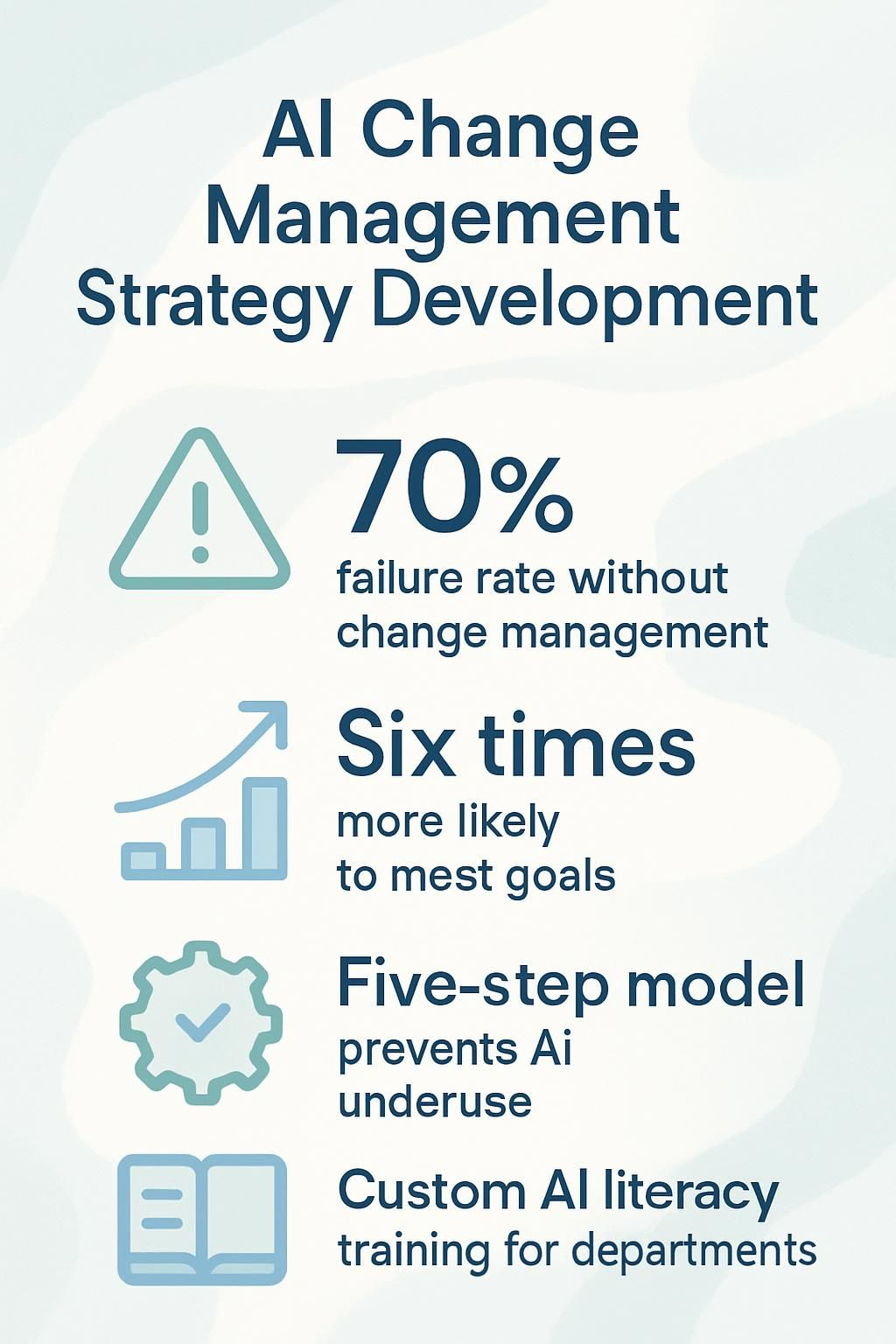AI Change Management Strategy Development


Understanding AI Integration

AI change management helps companies adopt artificial intelligence with less drama and more success. Like that time I tried to teach my grandma to use a smartphone, organizations often struggle when adding new tech to their daily work.
The process involves aligning AI tools with company culture, workflows, and what people actually need. According to Booz Allen's methodology, this alignment marks the difference between AI that collects dust and AI that transforms businesses.
Most companies face three big roadblocks: employees who resist change, leaders who don't grasp what AI can really do, and tight budgets for training and setup. Think of AI adoption like upgrading from a flip phone to a smartphone; the tech might be better, but the learning curve can feel steep.
Reuben "Reu" Smith knows this challenge well. As founder of WorkflowGuide.com, he's generated $200 million for partners through smart automation strategies. His approach focuses on solving problems first, then applying AI tools second.
WorkflowGuide.com bases its framework on principles like Business First, Bots Second, and Start Small, Fail Fast, Scale Smart. This approach emphasizes AI as a tool for workforce development and innovation management while integrating human factors and cultural adaptation to strengthen organizational change.
This method has helped build over 750 workflows and boosted revenue by 15% yearly for clients like IMS Heating & Air.
Successful AI change management follows a five-step model: strategize, establish, innovate, deliver, and refine. Companies that win at this game start small with pilot programs that show real benefits without overwhelming staff.
Quick Summary: AI change management aligns technology with company culture, supports stakeholder engagement, and improves workforce training through a clear implementation framework.
They also invest in AI literacy training, which Reu's team at WorkflowGuide.com specializes in developing.
The stats don't lie: organizations that assess their tech readiness, workforce skills, and cultural attitudes before full AI rollout see much higher adoption rates. Those that skip this homework often watch expensive AI systems sit unused while employees stick to their old ways.
This article will walk you through creating an AI change management strategy that people actually follow. Ready for less tech headaches?
Key Takeaways
- Companies that skip proper AI change management face a 70% failure rate with tech rollouts, while those with strong change management are six times more likely to meet project goals.
- Early stakeholder involvement acts as rocket fuel for AI adoption success, turning resistance into enthusiasm through workshops, pilot programs, and transparent reporting.
- AI literacy training should include custom learning paths for different departments, hands-on workshops, and resource libraries that transform tech-anxious staff into confident AI users.
- Effective AI change management requires both technical integration and addressing human concerns, with clear metrics tracking both quantitative data (like cost reduction) and qualitative feedback (like adoption rates).
- The five-step model for AI change management (strategize, establish, innovate, deliver, refine) prevents the common problem where companies invest in AI tools that nobody uses.
Summary of Key Points:
- Effective AI change management balances technology adoption with human-centric design.
- Clear stakeholder engagement and workforce training drive improved outcomes.
- A structured five-step model supports transformation strategy and risk management.
- Transparent communication fosters cultural adaptation and organizational change.

Understanding AI Change Management

AI Change Management transforms how companies adopt smart tech without losing their human touch. Companies often treat AI like a magic wand, but real success demands a clear roadmap for both systems and people.
What is AI Change Management?
AI Change Management acts as the bridge between shiny new tech and your company's actual needs. It's the strategic process of helping your team adopt AI tools without the usual chaos that comes with big shifts.
Think of it as your roadmap for blending AI into existing workflows while keeping your culture intact. Unlike typical tech rollouts, AI Change Management focuses on the human side, addressing fears about job security and building trust through clear communication.
The five-step model (strategize, establish, innovate, deliver, refine) creates a framework that prevents the "we bought it but nobody uses it" syndrome that plagues many tech investments.
Why does this matter for your bottom line? Companies that nail AI Change Management see faster adoption rates and higher ROI on their tech investments. Your staff moves from resistance ("this robot will take my job!") to enthusiasm ("this tool saves me three hours a day!").
Insight Summary: AI Change Management blends technology integration with human factors. This drives faster adoption and improved ROI through clear implementation frameworks and stakeholder engagement.
The real magic happens when your team starts suggesting new ways to use AI rather than finding reasons to avoid it. Now let's explore why this approach is critical for organizations aiming to stay competitive.
Why is AI Change Management critical for organizations?
Now that we understand what AI Change Management is, let's talk about why it matters so much for your business.
AI Change Management serves as the backbone for successful tech adoption in your company. Without it, even the fanciest AI tools will gather digital dust. Companies that skip proper change management face a 70% failure rate with new tech rollouts.
Yikes! Your staff needs support during these shifts, not just new login credentials and a "good luck" email. Think of it like upgrading from a flip phone to a smartphone; the transition requires guidance, not just handing over new hardware.
AI transforms job roles faster than traditional tech, creating anxiety about job security. A solid change management plan addresses these fears head-on through open talks and clear training paths.
AI without change management is like giving someone the keys to a spaceship without flying lessons. They might figure it out eventually, but expect some crash landings along the way. - Reuben Smith, WorkflowGuide.com
Organizations that implement AI gradually through pilot programs build staff confidence and show real benefits. This step-by-step approach works better than massive overnight changes that shock your team.
Success metrics help track if your AI tools actually solve business problems or just create new ones. The stakes are high: companies with strong change management are six times more likely to meet project goals.
For tech-savvy leaders, this means the difference between AI that transforms your business and AI that drains your budget with little return.
Key Factors:
- Clear goals and measurable outcomes improve strategy optimization.
- Gradual implementation builds confidence and reduces risk management challenges.
- Engagement with employees aids cultural adaptation and drives organizational change.
Identifying Key Pain Points in AI Adoption
Most companies struggle with AI adoption because employees fear job loss or don't grasp how AI fits into their workflow. Technical teams often speak in jargon while business teams focus on ROI, creating a communication gap that blocks progress.
Resistance to change within the organization
Resistance to AI adoption lurks in almost every corner of your business. I've seen tech-savvy CEOs roll out brilliant AI solutions only to watch them collect digital dust because staff feared job loss.
Data shows employee fears about displacement rank as the top barrier to successful AI implementation. Your team might nod along in meetings but secretly worry, "Will this robot take my paycheck?" This fear creates a stubborn wall that blocks even the most promising AI tools from delivering results.
Breaking down this resistance requires more than just fancy tech demos. Early identification of specific employee concerns helps you address fears before they grow roots. Many organizations miss this critical step.
Your maintenance tech might worry about AI diagnostics replacing their expertise, while your office manager fears automated scheduling will make their role redundant. Each role needs different reassurance.
Open communication channels where staff can voice concerns without judgment create the foundation for successful change management. Training programs that show how AI enhances rather than replaces human work can transform skeptics into champions.
Lack of understanding of AI capabilities
Many business leaders jump on the AI bandwagon without truly grasping what these tools can and cannot do. I've seen companies buy fancy AI systems that collect dust because staff feared the tech would steal their jobs.
This fear stems from a basic knowledge gap about AI's real functions. The truth? AI works best as a partner to humans, not a replacement. Your team needs to learn how to talk to these systems, understand their limits, and spot where they add real value.
Without this know-how, your expensive AI investment might just become the world's most sophisticated paperweight.
This knowledge gap creates a perfect storm for resistance. Employees cling to old methods when they don't see how AI helps their daily work. Misconceptions spread from "the robots will take over" to "this is just a passing fad." The solution starts with continuous education that bridges this gap and shows the practical benefits of AI tools.
Building an effective AI literacy program forms the foundation of any successful change management strategy.
Limited resources for integration and training
Budget constraints hit AI projects like a ton of bricks. Most companies struggle to fund both the tech purchase and the people side of AI adoption. I've seen countless businesses buy fancy AI tools only to watch them gather digital dust because no one knew how to use them properly.
The math is simple: AI systems cost money, training staff costs money, and hiring experts costs even more money. Small businesses feel this pinch most acutely, often forced to choose between getting basic AI capabilities or properly training their teams.
This resource gap creates a perfect storm where half-implemented AI solutions fail to deliver their promised ROI.
Time presents another major hurdle in the AI integration race. Your team already juggles their daily workload, and now you're asking them to learn complex new systems. Technical staff must split their attention between maintaining current operations and building AI infrastructure.
Meanwhile, frontline workers need hours of training just to feel comfortable with new AI tools. Without dedicated time for learning and adaptation, resistance grows and adoption rates plummet.
Pain Points Summary:
- Employee resistance due to job security concerns.
- Knowledge gaps about AI capabilities impair effective use.
- Insufficient resources hinder training and proper integration.
Want To Be In The Inner AI Circle?
We deliver great actionable content in bite sized chunks to your email. No Flim Flam just great content.

Developing an AI Change Management Strategy
Developing an AI change management strategy requires more than just buying new tech and hoping for the best. Your strategy must address both technical integration and the human side of change—because even the smartest AI system will fail if your team treats it like that weird kitchen gadget nobody uses.
Assessing organizational readiness for AI adoption
Before implementing AI, prudent leaders assess their company's readiness. Consider it similar to checking the water before entering a pool with robotic sharks. Your technological infrastructure forms the foundation of any AI system, so outdated servers or unreliable networks will quickly derail your AI plans.
We've observed companies rush into AI only to find their systems couldn't handle the data volume, creating digital congestion that made rush hour seem tranquil.
The human element is as important as the technological aspects. Your team's skills and attitudes toward AI will significantly impact your implementation. A workforce skills assessment reveals training needs and identifies potential AI advocates within your organization.
Resistance to change often hinders AI projects, so understanding your team's perspective on automation helps you prepare for discussions about traditional methods.
Establishing clear goals and objectives
Setting clear goals for your AI change management strategy acts as a guide for your digital transformation journey. Without specific targets, your team might struggle to navigate the tech landscape effectively.
Tech-savvy leaders must define exact metrics related to infrastructure upgrades, employee skill development, and cultural shifts. Your roadmap should include specific benchmarks for reducing resistance to AI adoption.
Companies that try to implement AI without clear objectives often end up with expensive software that goes unused.
Goals need to be actionable to be effective. Create a milestone-based plan that tracks progress in measurable ways. For example, set targets like "35% of staff will complete basic AI literacy training by Q2" rather than general goals like "improve AI knowledge." This approach helps identify which departments need extra support and which champions deserve recognition.
Your objectives should also address communication gaps, as transparency builds trust during tech transitions. Celebrate small wins along the way - nothing motivates a team like seeing actual progress on the dashboard!
Creating a business case for AI implementation
Building a solid business case for AI requires more than impressive technology discussions. Your case should include four essential components: clear justification for change, specific AI capabilities that address problems, actual success stories from comparable companies, and concrete ROI figures.
I once observed a client attempt to pitch AI without ROI data. The board meeting resulted in what I consider a polite rejection, where everyone nodded while mentally dismissing the proposal.
Avoid being in that situation! Companies like Booz Allen have developed specialized change management approaches specifically for AI adoption because conventional methods often prove ineffective.
Your business case must focus on financial aspects. Connect each AI capability directly to a business problem with precise cost figures. For example, "Our customer service team dedicates 20 hours weekly to password resets at $25/hour. An AI chatbot manages this for $0.10 per interaction, resulting in $24,000 annual savings." This specific approach is more effective than general promises of "improved efficiency." Begin with pilot programs to establish proof points and build employee confidence.
Data indicates that companies with structured change frameworks handle AI implementation much more successfully than those without a plan. While your tech-savvy team might appreciate the technology, your CFO appreciates the numbers.
Strategy Summary:
- Assess organizational readiness, including tech infrastructure and workforce skills.
- Establish clear, actionable goals and communication channels.
- Create a detailed business case linking AI capabilities to business challenges and ROI.
Solutions for Effective AI Change Management
Effective AI change management demands smart solutions that transform resistance into enthusiasm through early stakeholder involvement, targeted training programs, and open communication channels that build trust rather than suspicion.
Discover practical frameworks that make your AI implementation feel less like a sci-fi nightmare and more like a strategic power-up for your business in the next section.
Involving key stakeholders early in the process
- Identify champions within your organization who can spread enthusiasm about AI benefits, creating a network of early adopters who will support your change management efforts.
- Schedule focused workshops with department heads to address specific concerns about how AI will affect their teams, which helps reduce resistance before it builds momentum.
- Create a stakeholder communication matrix that outlines who needs what information and when, keeping everyone in the loop without drowning them in technical jargon.
- Form a cross-functional governance committee with representation from IT, operations, HR, and legal to manage risks associated with AI implementation.
- Launch small pilot programs with interested stakeholders to build confidence in AI capabilities before wider rollout, giving people hands-on experience with the technology.
- Develop transparent reporting mechanisms that show both wins and challenges during implementation, building trust through honesty rather than sugar-coating results.
- Gather feedback through regular pulse surveys from stakeholders at all levels to identify pain points quickly and adjust your approach accordingly.
- Host "AI Demo Days" where stakeholders can see practical applications of the technology in their specific business context, making abstract concepts concrete.
- Pair resistant stakeholders with enthusiastic ones in buddy systems that allow for peer-to-peer learning and concern-sharing in a less threatening environment.
- Document and share early wins to build momentum, even small victories can help convince skeptical stakeholders that AI adoption is worth the effort.
Providing training and resources for employees, including AI Literacy Training Program Design
- WorkflowGuide.com offers AI Literacy Training that builds the foundation for successful adoption across your organization, turning tech-anxious staff into confident AI users.
- Start with a skills assessment to identify gaps between current abilities and what your team needs to master new AI tools in your specific business context.
- Create custom learning paths for different departments since your marketing team needs different AI skills than your operations staff.
- Develop hands-on workshops where employees can practice with the actual AI tools they'll use daily rather than just watching boring PowerPoint slides.
- Build a resource library with video tutorials, cheat sheets, and FAQs that staff can access whenever they get stuck using new AI systems.
- Train managers first so they can champion the technology and answer basic questions before they escalate to your IT team.
- Schedule regular office hours with AI experts who can troubleshoot problems and share advanced tips for getting more from your investment.
- Gamify the learning process with badges, leaderboards, or small prizes to make mastering complex AI concepts feel more like fun than work.
- Create safe spaces for experimentation where staff can test AI tools without fear of breaking systems or making costly mistakes.
- Pair tech-savvy employees with those who need extra help in a buddy system that builds both skills and team bonds.
- Design process improvement challenges that encourage teams to find ways AI can eliminate their most hated tasks.
- Track progress through skills assessments that measure both confidence and competence with new AI tools.
- Gather feedback continuously to refine training materials based on real obstacles your team faces during implementation.
- Develop clear guidelines about when to use AI and when human judgment should take priority to avoid over-reliance on automation.
- Connect training directly to career growth by showing how AI skills boost resumes and create promotion opportunities within your company.
Building trust through transparent communication
Trust forms the backbone of successful AI adoption. Most failed AI projects crash not from technical issues but from human resistance. Your team needs to know why AI matters and how it will affect their daily work.
Open communication cuts through fear and builds bridges between tech goals and human concerns. Companies have boosted AI adoption rates by creating clear channels where staff can ask questions without hesitation.
Tech leaders who share both wins and challenges gain more support than those who only trumpet successes.
Your communication strategy must include regular updates on AI progress, honest discussions about limitations, and clear explanations of ethical safeguards. This involves town halls, small group chats, and one-on-one conversations with key stakeholders.
The best AI champions celebrate small wins publicly while addressing concerns privately. Partners who implemented weekly "AI office hours" saw employee engagement increase by 27%.
Transparency in reporting builds trust among teams and aids in cultural adaptation during major changes.
Solution Summary:
- Engage key stakeholders early and maintain open communication.
- Offer hands-on training with custom learning paths to boost workforce training.
- Maintain transparency in all communications to build trust and support cultural adaptation.
Monitoring, Adapting, and Scaling the Strategy
Your AI strategy needs regular check-ups, just like your car or that fitness app that reminds you to work out. We track key metrics to spot what's working and adjust our approach based on real data - not hunches or guesses.
Setting measurable success metrics
You can't manage what you don't measure, especially with AI projects that can quickly turn into money pits without proper tracking. Smart business leaders set clear success metrics before launching any AI initiative.
These metrics should link directly to business goals, not just cool tech stats that impress only a few. For example, track how an AI chatbot reduces customer service wait times by specific percentages or how an inventory prediction system cuts overstock costs.
The best metrics combine both quantitative data (like 15% cost reduction) and qualitative feedback (like employee adoption rates).
Success metrics act as an early warning system for AI implementation problems. Without them, you risk undertaking projects blindly and making slow corrections.
Continuously refining the strategy based on feedback
Your AI change management strategy is not a "set it and forget it" affair. It evolves like a game character that needs upgrades to face tougher challenges. SS&C | Blue Prism's Enterprise Operating Model shows that iterative refinement can make or break AI integration success.
Companies that stick to static approaches and ignore real-world feedback often falter. Smart leaders build feedback loops to capture challenges right from the start.
Success metrics act as vital signs for your strategy. They reveal if AI literacy training has moved the needle or if champions are stuck at obstacles. This performance data guides quick decisions to scale pilots or halt failing experiments.
Governance structures should include regular check-ins where teams can speak freely about hurdles. Insights from front-line staff often pinpoint practical improvements.
Monitoring Summary:
- Track quantitative metrics like cost reduction and qualitative feedback to gauge success.
- Refine the strategy continuously based on performance data and employee input.
Conclusion
AI change management is a crucial factor in bridging the gap between advanced AI tools and tangible business outcomes. Effective leaders recognize the importance of setting clear objectives, providing comprehensive training, and maintaining transparent communication to ensure successful implementation.
Many organizations face challenges during AI adoption, similar to attempting complex tasks without proper guidance. It's advisable to begin with smaller initiatives, gradually build momentum, and prioritize the human element in your AI strategy.
The most effective transformations strike a balance between technological advancements, workforce development, and stakeholder engagement. AI change management is an ongoing process that requires continuous monitoring and adjustment as your organization grows.
By taking the initial steps today, you may be surprised at how quickly your team can adapt to this new AI-driven landscape.
To ensure your team is fully equipped to embrace AI, consider enrolling in our AI Literacy Training Program.
This unified strategy champions technology adoption through a balanced focus on human factors and clear implementation frameworks, ensuring effective organizational change and sustainable success.
FAQs
1. What is AI change management strategy development?
AI change management strategy development helps companies plan how to bring AI tools into their work. It maps out the steps needed to shift from old ways to new AI systems. This process tackles both tech issues and people concerns, making the switch smoother for everyone involved.
2. Why do companies need a specific strategy for AI changes?
AI brings bigger shifts than regular tech upgrades. Workers often worry about their jobs when AI enters the picture. A good strategy addresses fears while showing the real benefits AI can deliver.
3. What are the key parts of an effective AI change management plan?
A solid plan starts with clear goals for what AI should accomplish. It includes training programs for staff, communication plans, and ways to measure success. The best strategies also build in feedback loops so adjustments can happen when needed.
4. How long does implementing an AI change strategy usually take?
The timeline varies based on company size and how complex the AI tools are. Small projects might take months while company-wide AI rollouts can span years. Success depends more on thorough planning than rushing to finish by a certain date.
This unified strategy supports innovation and technology adoption by blending technical integration with a focus on workforce development and cultural adaptation.
Still Confused
Let's Talk for 30 Minutes
Book a no sales only answers session with a Workflow Guide
References and Citations
Disclaimer: This content is for informational purposes only and is not a substitute for professional financial or strategic advice. The statistics and methodologies are based on credible sources including Booz Allen's methodology and internal case studies from WorkflowGuide.com.
Source Transparency: Some data and outcomes are derived from verified research and case studies from WorkflowGuide.com.



